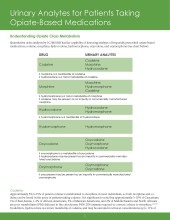Urinary Analytes for Patients Taking Opiate-Based Medications

Quantitative urine analysis by UPLC-MS/MS has the capability of detecting analytes of frequently prescribed opiate-based medications; codeine, morphine, hydrocodone, hydromorphone, oxycodone, and oxymorphone.
Codeine
Approximately 5% to 15% of parent codeine is metabolized to morphine in most individuals, so both morphine and codeine can be found in the urine of patients taking codeine. It is significant to note that approximately 5-10% of Caucasians, 1% of East Asians, 1-2% of African Americans, 3% of Mexican Americans, and 2% of Middle Eastern and North Africans are poor metabolizers (PM) deficient in the cytochrome P450 2D6 enzyme required to convert codeine to morphine.1,2,9,10 In addition, hydrocodone is a minor metabolite of codeine, and may be excreted in urine at concentrations up to 11% of parent codeine.1,4
Morphine
The primary analyte detected in urine of patients administered morphine is morphine itself, but several studies have suggested that hydromorphone is a minor metabolite. Small amounts of hydromorphone have been detected in combination with high concentrations of morphine in urine samples of patients prescribed morphine only.6,8 Certain investigators have suggested that codeine is also a minor metabolite of morphine, but most agree that codeine arises as an impurity in commercially manufactured morphine.1
Hydrocodone
Hydrocodone and hydromorphone are expected urinary analytes after hydrocodone consumption. Hydromorphone is a metabolite of hydrocodone. Rapid metabolizers excrete a significantly greater fraction of a dose as hydromorphone than do poor metabolizers (5.9% vs. 1.0% in 48 hour urine).1,9
Hydromorphone
The analyte detected in urine of patients administered hydromorphone is hydromorphone itself.1
Oxycodone
Analytes detected in urine after oxycodone administration include oxycodone and/or its metabolite oxymorphone.1,3,5 Hydrocodone is a potential impurity in commercially manufactured oxycodone preparations; therefore, a small quantity of hydrocodone could be detected in the urine of patients prescribed oxycodone only.
Oxymorphone
The primary analyte excreted in urine after the administration of oxymorphone is oxymorphone itself.1 Oxycodone is a potential impurity in the process of commercially manufactured oxymorphone; consequently, a small amount of oxycodone could be detected in the urine of patients prescribed oxymorphone only.2,7
References:
1. Baselt RC. Disposition of Toxic Drugs and Chemicals in Man. 6thed., Biomedical Publications, Foster City 2002.
2. Perrine D, The Chemistry of Mind-Altering Drugs, American Chemical Society, Washington DC. 1996.
3. Poyhia R, Seppala T, Olkkola KT, Kalso E. The pharmacokinetics and metabolism of oxycodone after intramuscular and oral administration to healthy subjects. Br J Clin Pharmacol 1992 Jun; 33(6):617-21.
4. Oyler JM, Cone EJ, Joseph RE Jr, Huestis MA. Identification of hydrocodone in human urine following controlled codeine administration. J Anal Toxicol. 2000 Oct; 24(7):530-5.
5. Purdue Pharmaceuticals. Stamford, CT 06901. 17 April 2007.
6. Yeh SY, McQuinn RL, Gorodetzky CW. Biotransformation of morphine to dihydromorphinone and normorphine in the mouse, rat, rabbit, guinea pig, cat, dog, and monkey. Drug Metab Dispos 1977 Jul-Aug; 5(4):335-42.
7. Endo Pharmaceuticals. Chadds Ford, PA 19317.
8. Cone EJ, Heit HA, Caplan YH, Gourlay D. Evidence of Morphine Metabolism to Hydromorphone in Pain Patients Chronically Treated with Morphine. J Anal Toxicol. 2006 Jan-Feb; 30(1):1-5.
9. Moff at AC, Osselton MD, Widdop B. Clarke’s Analysis of Drugs and Poisons. 3rd ed., Pharmaceutical Press, Grayslake, IL 2004.
10. DeLeon J, Armstrong SC, Cozza KL Clinical Guidelines for Psychiatrists for the Use of Pharmacogenetic Testing for CYP450 2D6 and CYP450 2C19. Psychosomatics. 2006 Jan-Feb; 7(1):75-85.


